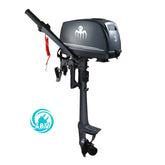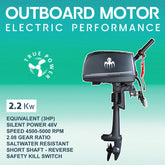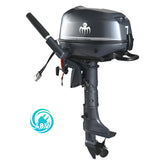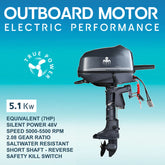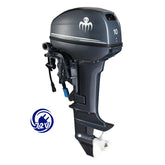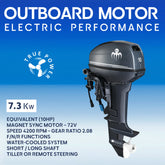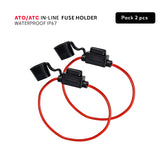AC vs DC Power Systems on Boats
AC vs DC Power Systems on Boats
A Marine Electrician's Guide to Choosing the Right Power
 Solution
Solution
When it comes to powering your boat, understanding the fundamental differences between AC (Alternating Current) and DC (Direct Current) systems isn't just technical knowledge—it's essential for safety, efficiency, and longevity of your marine electrical setup. Let's dive into why choosing the right power system can make or break your boating experience.
The Marine Environment Changes Everything
Unlike your home electrical system, boats present unique challenges that dramatically affect how AC and DC systems perform. The constant humidity, salt air, vibration, and space constraints mean that what works perfectly in your house might fail catastrophically on the water.
DC: The Marine Champion
Solar Panels and Engine Alternators: Natural DC Sources
Your boat's primary power sources are inherently DC systems. Solar panels with MPPT controllers and engine alternators generate direct current. Using inverters to convert this to AC and then back to DC for devices creates unnecessary heat generation—and heat equals wasted energy. Keeping your system DC from source to load maximizes efficiency.

Premium Marine USB Chargers
Low EMI, high-power delivery, marine-grade construction for reliable device charging.

Marine Thermal Breakers
Essential DC circuit protection designed specifically for marine environments.
Superior Circuit Protection
DC systems require specialized marine-grade thermal circuit breakers that are fundamentally different from AC breakers. These marine circuit breakers are designed to handle the unique characteristics of DC interruption, which is actually more challenging than AC due to the lack of natural zero-crossing points.
Built for the Marine Environment
DC appliances and components are typically designed for vehicle and marine applications from the ground up. This means they're engineered to withstand constant vibration, high humidity, temperature fluctuations, and salt air corrosion.
AC vs DC: Complete Comparison
| Aspect | AC System | DC System |
|---|---|---|
| Cable Requirements | Smaller wire sections for 110V/220V transmission | Larger, heavier cables required for 12V/24V systems |
| Safety Requirements | Requires differential breakers and GFCI protection | Simple thermal breaker protection sufficient |
| Equipment Cost | Cheaper appliances due to mass market production | Higher initial cost for marine-grade equipment |
| Durability | Home appliances not designed for marine conditions | Robust, seaworthy products built for harsh environments |
| Energy Efficiency | Power conversion losses, heat generation | Direct power delivery, minimal losses |
| Complexity | Requires inverters, complex safety systems | Simple, direct power distribution |
| EMI Generation | Inverters can create electromagnetic interference | Clean power, minimal interference with electronics |
| Maintenance | More complex troubleshooting and repairs | Simple diagnostics and maintenance |
AC: A Strategic and Essential Component
While a robust DC system is the foundation of a reliable boat, AC power remains an essential part of the modern marine electrical setup. It is not just for occasional use; a high-quality pure sine wave inverter is a critical component for powering high-load appliances and tools for which no practical DC alternative exists, such as microwaves, coffee makers, and power tools.
The Inverter: A Bridge to Modern Convenience
A pure sine wave inverter is more than just a converter; it's a bridge that allows you to safely and efficiently use standard home appliances from your boat's DC battery bank. Investing in a quality pure sine wave inverter is crucial, as it ensures clean, stable power that protects sensitive electronics from damage and minimizes electromagnetic interference (EMI). While all power conversion generates some heat and energy loss, modern inverters are highly efficient and, when used strategically, provide a safe and convenient solution that complements your primary DC system.
Safety Warning: Avoid Running 220V Throughout the Boat
High-voltage AC wiring presents serious safety risks in the marine environment. Keep AC wiring runs as short as possible, use proper marine-grade components, and install GFCI protection for all AC circuits.
EMI: The Hidden Enemy
Electromagnetic interference is a critical concern on boats packed with navigation equipment. Poor-quality power conversion equipment can affect GPS accuracy, radio communication, radar performance, and fish finder operation. This is why investing in quality marine USB chargers with low EMI output is essential.
Practical Recommendations
Prioritize DC Where Possible
- LED lighting systems
- Marine DC refrigeration
- Navigation and electronics
- Ventilation fans
- Water pumps and bilge systems
Use AC Strategically
- Power tools (occasional use)
- Kitchen appliances during shore power
- Devices without DC alternatives
The Bottom Line
While AC power has its place, DC systems offer superior reliability, efficiency, and longevity in the marine environment. With solar panels and engine alternators naturally producing DC power, maintaining a DC-focused system eliminates unnecessary conversion losses and heat generation.
Modern boats benefit from a robust DC foundation with quality components designed specifically for marine applications. This approach maximizes your power system's efficiency while ensuring the safety and reliability that marine environments demand.
Upgrade Your Marine Electrical System Today
Don't compromise on safety and efficiency. Invest in quality marine-grade DC components that are built to last in harsh marine environments.
Shop Premium USB Chargers Get Marine Circuit Breakers✅ Low EMI Design ✅ Marine Grade Construction ✅ Professional Quality
